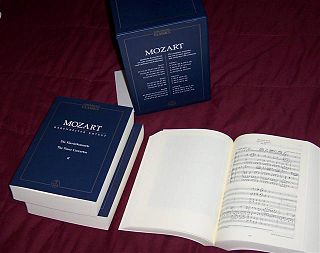Related Research Articles

Friedrich von Hagedorn was a German Rococo poet. He was born in Hamburg, where his father, a man of scientific and literary taste, was the Danish ambassador. His younger brother, Christian Ludwig, was a well known art historian and collector.

The Piano Sonata No. 12 in F major, K. 332 (300k) by Wolfgang Amadeus Mozart was published in 1784 along with the Piano Sonata No. 10 in C major, K. 330, and Piano Sonata No. 11, K. 331. Mozart wrote these sonatas either while visiting Munich in 1781, or during his first two years in Vienna. Some believe, however that Mozart wrote this and the other sonatas during a summer 1783 visit to Salzburg made for the purpose of introducing his wife, Constanze to his father, Leopold. All three sonatas were published in Vienna in 1784 as Mozart's Op. 6.

The Piano Sonata No. 13 in B-flat major, K. 333 (315c), also known as the "Linz Sonata", was composed by Wolfgang Amadeus Mozart in Linz at the end of 1783.

The Kegelstatt Trio, K. 498, is a piano trio for clarinet, viola and piano in E-flat major by Wolfgang Amadeus Mozart.

The Neue Mozart-Ausgabe is the second complete works edition of the music of Wolfgang Amadeus Mozart. A longer and more formal title for the edition is Wolfgang Amadeus Mozart (1756–1791): Neue Ausgabe sämtlicher Werke [Wolfgang Amadeus Mozart (1756–1791): New Edition of the Complete Works].

The Piano Concerto No. 8 in C major, K. 246, or Lützow Concert was written by Wolfgang Amadeus Mozart in April 1776 in the same year as the Haffner Serenade. Countess Antonia Lützow, who was 25 or 26 years old at the time, was the second wife of Johann Nepomuk Gottfried Graf Lützow, the Commander of the Hohensalzburg Fortress. She was a fine pianist. The solo work is not highly demanding, but it requires agility. Mozart played the concerto in Mannheim and Munich on October 4, 1777, and used it for teaching. Three cadenzas by Mozart have survived. Kitano concludes that the first two cadenzas, A and B in the Urtext edition, may have been written for the Countess Lützow herself to accommodate her limited technical ability, while cadenza C more resembles what Mozart might have played when he performed the work in Augsburg in 1777.

Wolfgang Amadeus Mozart's Piano Sonata No. 10 in C major, K. 330 / 300h, is one of the three works in the cycle of piano sonatas K.330-331-332. The sonata was composed in 1783, when Mozart was 27 years old. It was published, with the other two sonatas by Artaria in 1784. A typical performance of this sonata lasts around twenty minutes.

"Leck mir den Arsch fein recht schön sauber" is a canon for three voices in B-flat major, K. 233/382d. The music was long thought to have been composed by Wolfgang Amadeus Mozart during 1782 in Vienna, but now thought to be the work of Wenzel Trnka. The lyrics appear to stem from Mozart.

Wolfgang Amadeus Mozart's Piano Sonata No. 17 in B♭ major, K. 570, dated February 1789, is a sonata in three movements:

"Als Luise die Briefe ihres ungetreuen Liebhabers verbrannte", K. 520, is a song for piano and voice (soprano) by Wolfgang Amadeus Mozart to a poem by Gabriele von Baumberg.
The Rondo for Piano and Orchestra in A major, K. 386 is a concert rondo by Wolfgang Amadeus Mozart, believed by Alfred Einstein to have been composed in late 1782.

"Das Veilchen", K. 476, is a song for voice and piano by Wolfgang Amadeus Mozart, written in Vienna on 8 June 1785, to a poem by Johann Wolfgang von Goethe.
Fantasia No. 4 in C minor, K. 475 is a composition for solo piano composed by Wolfgang Amadeus Mozart in Vienna on 20 May 1785. It was published as Opus 11, in December 1785, together with the Sonata in C minor, K. 457, the only one of Mozart's piano sonatas to be published together with a work of a different genre.
"Bei der Hitz im Sommer eß ich" is a canon for three voices in G major, K. 234/382e. The music was long thought to have been composed by Wolfgang Amadeus Mozart during 1782 in Vienna, but now thought to be the work of Wenzel Trnka. The lyrics appear to stem from Mozart.
Six Variations on "Hélas, j'ai perdu mon amant", K. 360/374b, is a composition in G minor for piano and solo violin by Wolfgang Amadeus Mozart, composed when he was 25 years old.

"An Chloe", K. 524, is a composition for voice and piano by Wolfgang Amadeus Mozart to a poem by Johann Georg Jacobi. Mozart composed it on 24 June 1787 in Vienna.

Wolfgang Amadeus Mozart composed four litanies in his service as a church musician for the Salzburg Cathedral, two of which are settings of the Litaniae Lauretanae, the Litany of the Blessed Virgin Mary. The other two are settings of the Litaniae de venerabili altaris sacramento, venerating the Eucharist. Mozart composed the works for four soloists, choir, instruments, and continuo. The litanies appeared in Bärenreiter's Neue Mozart-Ausgabe (NMA) in 1969.
"Das Traumbild", K. 530, is a song, or Lied, for piano and voice by Wolfgang Amadeus Mozart to a poem by Ludwig Hölty.
"Abendempfindung an Laura", K. 523, is a song by Wolfgang Amadeus Mozart dated June 24, 1787, in Vienna, written at the time of the opera Don Giovanni and Eine kleine Nachtmusik.
References
- ↑ Die Alte (song) at the Mutopia Project
- ↑ NMA score
- ↑ NMA Critical Report, p. 122